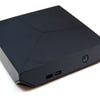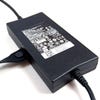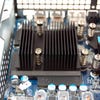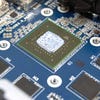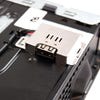Alienware Alpha review
Digital Foundry on the mini living room PC with the horsepower to take on PS4 and Xbox One.
When Valve decided to postpone its Steam Machines initiative, its hardware partners were left in a difficult position - hold back on their living room-friendly PCs and wait for the final SteamOS and controller, or repackage their offerings as more traditional Windows-orientated PCs? Alienware went for the latter with its innovative Alpha console/PC hybrid, going to the trouble of engineering its own console-style user interface in order to make the machine fully operable without mouse and keyboard. The bolt-on UI is a bit of a kludge to be honest - and that's a shame, as the hardware design story here is quite remarkable.
Let's start with some basic facts: the Alienware Alpha is significantly smaller than the PlayStation 4 (in fact, it's absolutely tiny), it's significantly more energy efficient, it's quieter, and it has something the consoles don't - complete access to a mammoth back-catalogue of games. While there's plenty to discuss about the overall power level of the Alpha's hardware, it's clearly capable of competing with the Sony hardware on recent titles, and its performance is quantifiably a step ahead of Xbox One. Indeed, some might say that it's the physical embodiment of a key challenge the latest wave of consoles will have going forward - their designs were finalised two to three years ago, while PC hardware development continues to improve significantly year-on-year. This year's Alpha is in no way a knockout blow to the consoles, but two to three years down the road, it could be a different story.
We've already covered the raw specs of the Alienware Alpha subsequent to a PR briefing we attended at the latter end of 2014, but getting the kit into the office allows us a much more forensic examination of the hardware. We were sent the base level offering for review - a console armed with a low-voltage Intel Core i3-4130T: a dual-core, quad-thread CPU capable of hitting 2.9GHz. This works in combination with an apparently customised version of the laptop GTX 860M - effectively identical to the desktop GTX 750 Ti, losing just a little memory speed.
Rounding off the basic spec we have a rather slow 5400rpm 2.5-inch laptop hard drive and 4GB of low-voltage DDR3 clocked at 1600MHz. For the purposes of testing the hardware adequately with the latest games, we upgraded that to 8GB - that's a spec option available on the Dell site, in combination with 1TB hard drives along with Core i5 and i7 quad-core CPU upgrades. Higher-end models also come with improved 2x2 Intel WiFi too, but you can replace this component yourself if you really want to.
- Order the Alienware Alpha from Amazon with free shipping
Booting up the machine is a fairly long and laborious process, not helped by the slow hard drive. Windows takes 82 seconds to finish loading, while the Alpha UI requires an additional 30 seconds on top of that. The UI itself - apparently based on a customised build of the XBMC media-player front end - replaces Windows in terms of accessing core functionality, such as display resolutions, audio options etc. Everything is controlled with the supplied Xbox 360 controller, connecting to the Alpha via a USB wireless receiver (the console itself has a special compartment on its underside with a USB port designed explicitly for Valve's own receiver, when it eventually appears). What's surprising is that the Alienware UI actually does very little else - accessing games is carried out by Steam via its standard Big Picture mode interface. In effect, there's a UI within a UI - a compromised state of affairs that isn't exactly ideal and is functional at best.
It also limits you to the Steam library, meaning that if you want to play the full range of PC games - and venture into Origin and uPlay territory - you'll need to log out of the Alienware front-end and access the standard Windows 8.1 desktop. From there, the Alpha runs just like a normal PC - just attach a keyboard and mouse and you're on your way.
Our first port of call was to install MSI Afterburner and GPU-Z - two tools that allowed us to ascertain that the Alpha's apparently custom Nvidia GPU has a set-up identical to the standard laptop GTX 860M. Early leaked specs on the Alpha suggested a memory overclock from 5gbps to 6gbps - but that hasn't happened. As far as we can tell, integration apart, there is nothing custom about the GTX 860M here at all. Far from being faster than the 750 Ti as we were told at the briefing, it's actually a bit slower owing to lower memory bandwidth. While specs might not have changed, there is something different with Alienware's GPU though - a major annoyance is that Nvidia's drivers won't install, and the unit is supplied with a reasonably recent, but not up-to-date alternative. Worse still, positively ancient drivers are on the Dell support site - not even the versions supplied with the hardware itself. A key Nvidia strength is its strong driver support, along with the GeForce Experience game optimiser that allows users to choose between image quality and performance without having to worry about tweaking individual in-game settings. The Alpha doesn't work with GFE, and prospective owners are currently missing out on Nvidia's efforts to ensure that each new game is backed by a fresh release of optimised drivers. This really needs sorting out.
However, desktop access does allow us to install MSI Afterburner, and the good news is that the onboard GPU is just as overclockable as the desktop GTX 750 Ti, despite the limited form factor and the pared-back cooling assembly. The core clock can be boosted by 135MHz over its 1097MHz maximum, and the laptop GTX 860M memory speed reduction in comparison to its desktop counterpart is also reversible - we upped this from 5gbps to 6gbps, with the system overall remaining totally stable throughout testing. GPU temperatures rose by just three degrees Celsius, suggesting that the chip could probably be pushed further were it not for its locked BIOS.
Playing Crysis 3 with the Alpha hooked up to a wattmeter produces some remarkable results. In its standard configuration, the hardware draws a maximum of 85W - that's up against 125W for Xbox One and 130W for PS4. Overclocking the GPU takes us up to just 90W. Replacing the Core i3 CPU for a quad-core i5 sees us hit a 100W wall - the Alpha comes with a 140W PSU and appears to throttle components rather than extract any more juice. The upshot of this low power consumption is that the Alpha is very quiet too.
In benchmarking the hardware, we wanted to push the system to its limits. We ran the system through a number of games at its stock settings, following that up with a repeat procedure with the GPU and GDDR5 overclocks in place. Finally, we replaced the Core i3-4130T with a Devils Canyon Core i5-4690K, retained the GPU overclocks and tested again. At this point it's worth pointing out that while the Alpha happily runs with any Socket 1150 Haswell CPU, it artificially limits clocks to stay within its power window. In the case of our i5 it'll happily sit at 3.9GHz all day in a desktop machine with adequate cooling - and you can overclock it to 4.6GHz too. In the Alpha, we noted a top speed of just 2.7GHz, quickly dropping and settling at 2.6GHz. In short, the Alpha treats your desktop chips as low-voltage variants, throttling performance to match.
Onto the benchmarks then. We're currently in the process of updating our collection of test titles to accurately reflect the mandatory 64-bit, DirectX 11 era that the new consoles have brought about. But in the here and now, Battlefield 4, Crysis 3 and Tomb Raider remain, joined by newcomers in the form of Middle-earth: Shadow of Mordor, Call of Duty Advanced Warfare, Ryse and Metro Redux. There's little point maxing out GPU settings on entry-level enthusiast graphics hardware like the GTX 860M, so we've generally gone for settings one notch down from the max, while removing bandwidth-intensive options like multi-sampling anti-aliasing (MSAA). In short, we've tried to match the settings to the way we'd actually play each title on this level of PC hardware.
The results are encouraging. We've found a number of recent multi-platform titles perform rather nicely on the GTX 750 Ti, usually in line with PlayStation 4 performance, and so it is with the very similar GTX 860M found in the Alienware Alpha. Based on benchmarking sequences alone, the GPU overclock has much more of an immediate impact on frame-rates rather than the i5 upgrade - across the seven titles tested we noted, performance increased by an average of 13.5 per cent, but frame-rate averages barely moved in the step-up to a faster processor - a raw statistic that isn't in keeping with general gameplay testing, as we'll explain later.
All titles were tested at 1080p, but results shouldn't really be compared with their console equivalents. For example, Metro Last Light Redux runs at a locked 60fps on PS4, and here the best we could manage was an average of 44.6fps. However, 4A's benchmark sequence is more challenging than anything in actual gameplay, and we were running with motion blur and high tessellation enabled - features disabled on the PS4 version. Meanwhile the PC version of Tomb Raider on high settings is a fairly close match to the PS4 game, but there's no equivalent to the console version's TressFX 2.0. Running with non-Tress hair, performance is significantly higher than the PS4 release. On the flipside, Battlefield 4 frame-rates look sub-par, but if you run the game at the same 1600x900 resolution as the PS4 title, performance is actually better than the console titile. In short, treat these numbers as guidelines, not any kind of final word on gaming performance.
| Core i3-4130T/ GTX 860M | Core i3-4130T/ GTX 860M OC | Core i5-4690K/ GTX 860M OC | |
|---|---|---|---|
| Battlefield 4 | 42.5 | 47.5 | 48.4 |
| Crysis 3 | 39.5 | 44.7 | 45.7 |
| Metro Last Light Redux | 39.1 | 44.0 | 44.6 |
| Middle-earth: Shadow of Mordor | 38.3 | 44.6 | 45.5 |
| Tomb Raider | 67.2 | 78.2 | 78.2 |
| Ryse | 26.5 | 30.1 | 30.4 |
| COD Advanced Warfare | 58.9 | 66.0 | 67.0 |
So perhaps the real question is how the Alpha feels like to play in actual gameplay conditions. Previously, we've run a full-voltage Core i3-4130 in combination with a GTX 750 Ti (a set-up very close to the Alpha's base spec) and produced some great results on 1080p gameplay, matching and sometimes even exceeding PS4 performance. However, the Alienware console in its base spec does sometimes fall a little short. Our impression is that the base-spec Alpha could do with a little more CPU power - our desktop Core i3 set-up hits 3.5GHz, and assuming you're targeting 30/60fps, it offers most of an i5's capabilities, but there are moments where stutter creeps in. The Alpha's 2.9GHz low-voltage chip is more prone to this kind of stutter - almost all of which vanishes when you move up to an i5.
You can get a much better idea of the effect in motion by checking out the Crysis 3 gameplay video below. We're using the same quality presets as the benchmark run - high settings, very high quality textures and SMAA T2X anti-aliasing - but with v-sync engaged to eliminate tearing. You'll note that the GPU overclock produces an almost constant boost to performance, but some of the lowest dips to frame-rate occur only on the i3 tests, with the i5 moving ahead in several areas with a palpable increase to performance. It's still an uneven experience though - we'd recommend engaging a 30fps lock - but it looks absolutely stunning.
Crysis 3 may well be an extreme example of a truly power-hungry game, but examples of a CPU deficit on the base model crop up fairly frequently during gameplay, just not quite to the same level. Check out this shot of Metal Gear Solid 5: Ground Zeroes, for example. Stutter creeps in on the i3 Alpha whether the GPU is overclocked or not - and only by moving to the i5 is it eliminated. The bottom line is that the Alienware machine operates on an extremely tight power budget: the base model uses just 66 per cent of the power drawn by the PS4 during gaming. This results in occasional compromises to performance you may not find on the console, nor on desktop PC parts, where power consumption and thermals are not really an issue.
Alienware Alpha: the Digital Foundry verdict
During our briefing last year with Alienware, execs had the machine plugged into an HDTV and playing Fez. No claims were made for the device as a performance powerhouse - rather it was described as a living room-friendly PC designed for lighter gaming in a more social environment. However, our own experiments with entry-level enthusiast gaming hardware very similar to the Alpha's innards reveal that this kind of kit can run a great many AAA titles with console-level quality and performance. Despite its power and thermal constraints, the Alpha acquits itself very well as a console capable of running the latest games - though potential users should take their cues from the console versions on where to make the trades when it comes to graphics settings.
We rather like the Alpha - it's an ingenious design that's well put together. Alienware has created something unique - an ultra-small form factor gaming PC that, while compromised in certain respects, offers the power of a modern console with all of the advantages of an open platform. Its one key drawback is obvious, though: GPU power continues to advance in leaps and bounds year-on-year and this is the one area of the package that cannot be upgraded. There'll come a time a couple of years down the line where entry-level enthusiast GPU parts offer enough raw horsepower to offer a more future-proof solution, but in the here and now, the GTX 860M essentially offers performance ballpark with PS4 - good enough for today, but for how long?
Of course, there is nothing stopping you building your own living room PC based on the Mini-ITX form-factor, though it won't be as small as the Alpha, and it may not be quite so cost-effective. Alienware has a reputation as a premium brand with a cost mark-up to match, but the base level Alpha starts at £449 (and was available for under £400 over Christmas). Bearing in mind that you're getting a complete package, including Windows 8.1 and a wireless controller, that's a pretty good deal - especially as good quality Mini-ITX cases, power supplies and motherboards tend to be quite pricey. However, to get the most out of the Alpha, we'd have to recommend the i5 model with 8GB of RAM - not so cheap at £570, but two upgrades we feel you'll be making sooner or later anyway.



